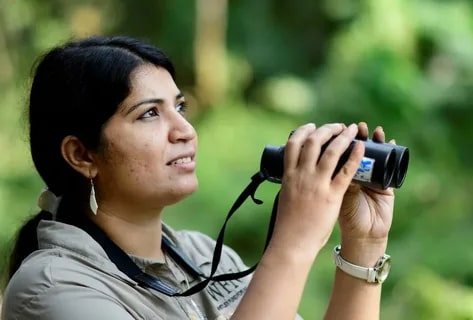Dr. Purnima Devi Barman, Founder of the Hargila Army and Senior Project Manager of the Avifauna Research and Conservation Division, Aaranyak, India.
«Ecological restoration is so important to save our biodiversity and to save ourselves. Each person, each species, we are connected with a single thread»
At the age of five, Barman was sent to live with her grandmother on the banks of the Brahmaputra River in the Indian state of Assam. Separated from her parents and siblings, the girl became inconsolable. To distract her, Barman’s grandmother, a farmer, started taking her to nearby paddy fields and wetlands to teach her about the birds there.

“I saw storks and many other species. She taught me bird songs. She asked me to sing for the egrets and the storks. I fell in love with the birds,” said Barman, a wildlife biologist who has devoted much of her career to saving the endangered greater adjutant stork, the second-rarest stork species in the world.
A species in decline
Fewer than 1,200 mature greater adjutant storks exist today, less than 1 per cent of what they numbered a century ago. The dramatic decline in their population has been partly driven by the destruction of their natural habitat. Wetlands where the storks thrive have been drained, polluted and degraded, replaced by buildings, roads and mobile phone towers as the urbanization of rural areas gathers pace. Wetlandsnurture a great diversity of animal and plant life but around the world they are disappearing three times faster than forests due to human activities and global heating.
Human-wildlife conflict
After gaining a Master’s degree in Zoology, Barman started a PhD on the greater adjutant stork. But, seeing that many of the birds she had grown up with were no more, she decided to delay her thesis to focus on keeping the species alive. She began her campaign to protect the stork in 2007, focusing on the villages in Assam’s Kamrup District where the birds were most concentrated – and least welcomed.
Here, the storks are reviled for scavenging on carcasses, bringing bones and dead animals to their nesting trees, many of which grow in people’s gardens, and depositing foul-smelling droppings. The animals stand about 5 ft (1.5 metres) tall with wingspans of up to 8 ft (2.4 metres) and villagers often prefer to cut down trees in their backyards than allow the storks to nest in them. “The bird was totally misunderstood. They were treated as a bad omen, bad luck or a disease carrier,” said Barman, who was herself mocked for attempting to save nesting colonies.

Conflict between people and wildlife is one of the main threats to wildlife species, according to a 2021 report from the World Wildlife Fund and the United Nations Environment Programme (UNEP). This conflict can have irreversible impacts on ecosystems which support all life on Earth. The UN Decade on Ecosystem Restoration provides an opportunity to mobilize the global community to re-balance the relationship between people and nature.
‘Hargila Army’
To protect the stork, Barman knew she had to change perceptions of the bird, known locally as “hargila” in Assamese (meaning “bone swallower”) and mobilized a group of village women to help her.

Today the “Hargila Army” consists of over 10,000 women. They protect nesting sites, rehabilitate injured storks which have fallen from their nests and arrange “baby showers” to celebrate the arrival of newborn chicks. The greater adjutant stork regularly features in folk songs, poems, festivals and plays.
Barman has also helped to provide the women with weaving looms and yarn so they can create and sell textiles decorated with motifs of the hargila. This entrepreneurship not only spreads awareness of the bird, it also contributes to the women’s financial independence, boosting their livelihoods and instilling pride and a sense of ownership in their work to save the stork.

Since Barman started her conservation programme, the number of nests in the villages of Dadara, Pachariya, and Singimari in Kamrup District have risen from 28 to more than 250, making this the largest breeding colony of greater adjutant storks in the world. In 2017, Barman began building tall bamboo nesting platforms for the endangered birds to hatch their eggs. Her efforts were rewarded a couple of years later when the first greater adjutant stork chicks were hatched on these experimental platforms.
Restoring ecosystems
For Barman, safeguarding the adjutant stork means protecting and restoring their habitats. The Hargila Army has helped communities to plant 45,000 saplings near stork nesting trees and wetland areas in the hope they will support future stork populations. There are plans to plant a further 60,000 saplings next year. The women also carry out cleaning drives on the banks of rivers and in wetlands to remove plastic from the water and reduce pollution.
“Purnima Devi Barman’s pioneering conservation work has empowered thousands of women, creating entrepreneurs and improving livelihoods while bringing the greater adjutant stork back from the brink of extinction,” said Inger Andersen, Executive Director of UNEP. “Dr Barman’s work has shown that conflict between humans and wildlife can be resolved to the benefit of all. By highlighting the damaging impact that the loss of wetlands has had on the species who feed and breed on them, she reminds us of the importance of protecting and restoring ecosystems.”
Barman says one of her biggest rewards has been the sense of pride that has been instilled in the Hargila Army and she hopes their success will inspire the next generation of conservationists to pursue their dreams. “Being a woman working in conservation in a male-dominated society is challenging but the Hargila Army has shown how women can make a difference,” she said.
Sourse: https://www.unep.org/championsofearth/ru/laureates/2022/d-r-purnima-devi-barman














